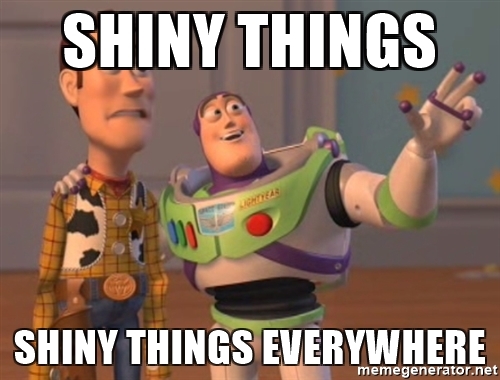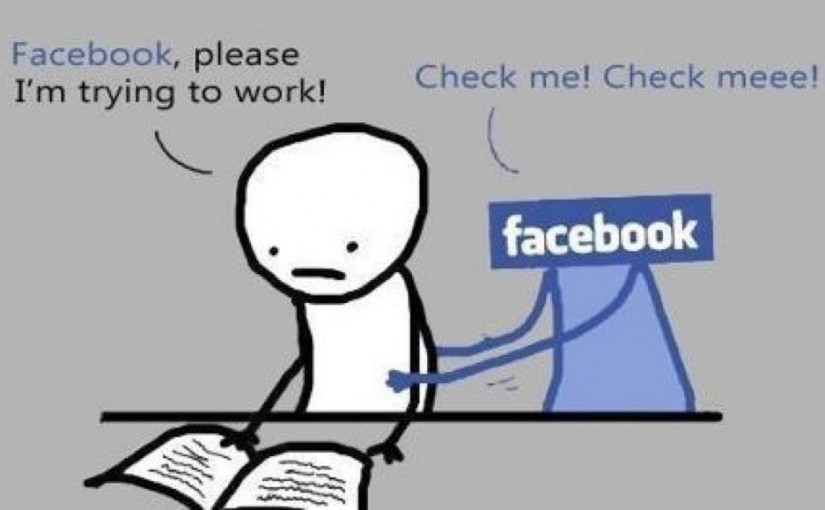After a particularly dull meal at my parents’ home, I went into the kitchen opening tins of chips and biscuits to look for something to excite my taste buds. One moment, my hands were busy, but the next moment, I froze. Something had just occured to me. I had found my main course boring, so I was looking for distracting tidbits. I wasn’t even hungry. What my mom had made was healthy and good for the long term. I was looking for short term gratification. I started reviewing. How often do I look for distractions that are gratifying for the short term, while I should be working on something that moves me towards my long term goals. In fact how often does everyone do it?
The shiny object effect
We have seen this often. Someone ought to be working on a book, but the app open on the screen is not Microsoft Word, rather Chrome with Facebook.
Leisure time ought to be spent in reading books or watching documentaries to learn some skill or increase our knowledge of the world around us. But we may feel too tired to read or too bored to watch a documentary and instead watch an action, comedy or romantic movie or a daily soap to give the brain an temporary boost.
People ought to invest smartly in instruments that will earn them money over the long term. But waiting for money to grow steadily is too boring. So people look for instruments that they think will yield them double or triple their principal.
Your brain is looking for instant gratification over the benefits of long term efforts through discipline. That’s how the brain is wired. It hates waiting and wants everything now. The brain avoids boring and difficult tasks in favour of easy or no-effort tasks and instant gratification. These instant gratification activities are called shiny objects, because your brain shifts focus and latches onto them just like your eyes would follow and keep starting at a shiny object.

How can you get the brain back on track to get it to focus long term? Here are some tips.
Be aware
I was lucky to catch myself at the right time before I dug out some chips and biscuits. I had a moment of awareness about what I was doing. When I recognised what I was doing, I could take a U-turn and walk away from the snacks. The moment of awareness is what counts. You have to keep reminding yourself if you are slipping. Sometimes it takes a few seconds, but sometimes it takes several minutes to realise that you are going down the rabbit hole of instant gratification and distraction. I had a chance revival from my distraction. But you can make yourself as system that brings you back on track.
Consider a railway motorman’s alarm. A railway motorman is supposed to tap a foot pedal every few minutes to prove to the train that he/she is awake. An alarm is sounded by the locomotive when the motorman needs to press the pedal. If the pedal is not pressed within a few seconds of the alarm going off, the train assumes that the motorman is asleep and that he/she is not focusing on piloting the train. Emergency brakes engage automatically to stop the train.
This is the reverse of Pomodoro technique. In the Pomodoro technique, you set an alarm for 25 minutes from now, so that you work with full focus during the those 25 minutes. The alarm after 25 minutes reminds you to take a break after an intense session of work. The motorman’s alarm is the reverse. Alarms are set to remind you that you are getting distracted or looking for instant gratification.
A good way is to use a scheduling app like Google Calendar or Google Reminders. A reminder every 15 minutes towards your task, catches you cold if you are distracted. For other distractions such as temptation towards snacks when you should be eating your regular meals, you can tape sticky notes to your tin of snacks saying that you are only allowed snacks at a specific time of the day, say tea time.
Make distractions incredibly hard to get to
In the book Decisive, Chip and Dan Heath talk about a term called tripwire. Tripwires are meant to snap you out of your current automatic behaviour and force you to make a decision. They talk about a method called partitioning where you split up resources and make it hard to overconsume them. E.g. In a box of cookies, if each cookie is wrapped in a foil, then the inconvenience of having to unwrap the foil for every cookie you eat is often enough to prevent you from consuming excessive cookies.

I find this ingenius idea brilliant for preventing distractions and instant gratification. Turning off the Internet or disconnecting from WiFi is often enough to discourage you from binge checking Facebook, especially when your work is on Microsoft Word that can perfectly work offline. Disconnecting all the wires, everything from the power wires to the HDMI cables and even taking out your cable subscriber’s card from the set top box can effectively discourage TV watching. Asking your spouse to keep changing your netbanking password or your bank account card’s PIN code is good enough for you to stay away from touching the money you have stashed away for steady growth.
Try to add some excitement into your boring process
Let’s face it. We keeping going to Facebook because it is fun. We keep looking for chips because it is fun to eat them. Short-selling on the stock market and earning a sudden windfall is fun. It is fun that distracts us from boring long term tasks and shoos us towards the gratification tasks. What if we can add fun to our seemingly boring long term task itself? You can. You need some imagination and to think hard about what you can do.
If you are bored of bicycling or running, you can use an app like Google Fit or Endomondo to track your exercise and beat your records or those of your friends. You can improve your route by avoiding boring city roads and using a road that goes through a beach, a national park or a canopy of trees. You are allowed to use 1% of your savings to try ‘exciting’ investments such as short-selling stock. The other 99% go to long term savings. As a trivial example, let’s say you have ₹ 1000. You are allowed to use ₹ 10 for your excitement, while ₹ 990 go into steady investments. If you win, say your ₹ 10 becomes ₹ 100, then your net worth is now ₹ 1100. So you are allowed to use ₹ 11 during your next excitement investment. On the other hand, if you lose all of those ₹ 10, then you are only allowed to use ₹ 9.90 the next time. Sticking to this ratio allows you to experiment with excitement-inducing investments and accordingly punish or reward that behaviour based on the results.
Another method is to use temptation bundling to pair a boring task with something you really love. Priya has talked extensive about it here.
Remind yourself about the long term benefits
Sometimes a little emotional motivation can help. You have to ask yourself why you are are doing a certain activity. It may be boring for now, but the results over the longer term will be exactly what you want out of your life. Every time you feel like escaping from what you are doing or you find yourself distracted, remind yourself why you planned to do that which is boring and what you will be in the future as a result. But also remember that despite the motivation, if you still do not feel like doing what you are doing, you shouldn’t be involved in that activity in the first place and maybe you are in it for the wrong reasons. So some soul searching will help.
Conclusion
When you are doing something boring, difficult or frustrating, looking for an escape and getting distracted is a natural thing to do as your brain is wired for it. However you can stay on top of it by being smart and staying alert. Your mind will be distracted inevitably and you should be ready for that and acknowledge it. I wish you a great, successful life where you break through distractions and short-term gratification and be the person you always wanted to be.

Self-discipline with some process. This is the stuff legends are made of 😛